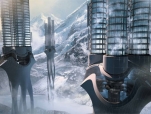Architectural Mysterium

The eVolo Magazine has announced the winners of the 2012 Skyscraper Competition. The annual competition recognizes outstanding ideas that redefine skyscraper design through the use of new technologies, materials, programs, aesthetics, and spatial organizations, along with studies on globalization, flexibility, adaptability, and the digital revolution. This is also an investigation on the public and private space and the role of the individual and the collective in the creation of a dynamic and adaptive vertical community. The award seeks to discover young talent, whose ideas will change the way we understand architecture and its relationship with the natural and built environments.
Flight of imagination of young architects has no boundaries. Among the honorable mentions there are underwater projects for ocean research, mobile skyscrapers, floating cities, and temporal buildings that attach to existing structures. These proposals offer us an exciting view of the world to come. The first place was awarded to Zhi Zheng, Hongchuan Zhao and Dongbai Song from China for their project “Himalaya Water Tower”. In the Himalaya Mountains housed within 55,000 glaciers, sits 40 percent of the world’s fresh water. The massive ice sheets are melting at a faster-thanever pace due to climate change, posing possible dire consequences for the continent of Asia and the entire world stand, and especially for the villages and cities that sit on the seven rivers that are fed from the Himalayas’ runoff as they respond with erratic flooding or drought.
The “Himalaya Water Tower” is a skyscraper located high in the mountain range that serves to store water and helps regulate its dispersal to the land below as the mountains’ natural supplies dry up. The skyscraper, which can be replicated en masse, will collect water in the rainy season, purify it, freeze it into ice and store it for future use. The water distribution schedule will evolve with the needs of residents below; while it can be used to help in times of current drought, it’s also meant to store plentiful water for future generations. The lower part of the Himalaya Water tower is comprised of six stemlike pipes that curve and wind together and collect and store water.
Like the stem of a plant, these pipes grow strong as they absorb their maximum water capacity. In each of the six stems, a core tube is flanked by levels and levels of cells, which hold the water. The upper part of the building – the part that is visible above the snow line – is used for frozen storage. Four massive cores support steel cylindrical frames that, like the stems below, hold levels that radiate out, creating four steel tubes filled with ice. In between the two sections are mechanical systems that help freeze the water when the climatic conditions aren’t able to do so, purify the water and regulate the distribution of water and ice throughout the structure. At the bottom of the structure, surrounding the six intertwined water tubes is a transport system that regulates fresh water distribution to the towns and cities below. The curving channels connect the mountains to the villages, and are also hold within them a railway for the transport of people and goods.
Full version you can download here
 Materials provided by the eVolo magazine
Materials provided by the eVolo magazine


